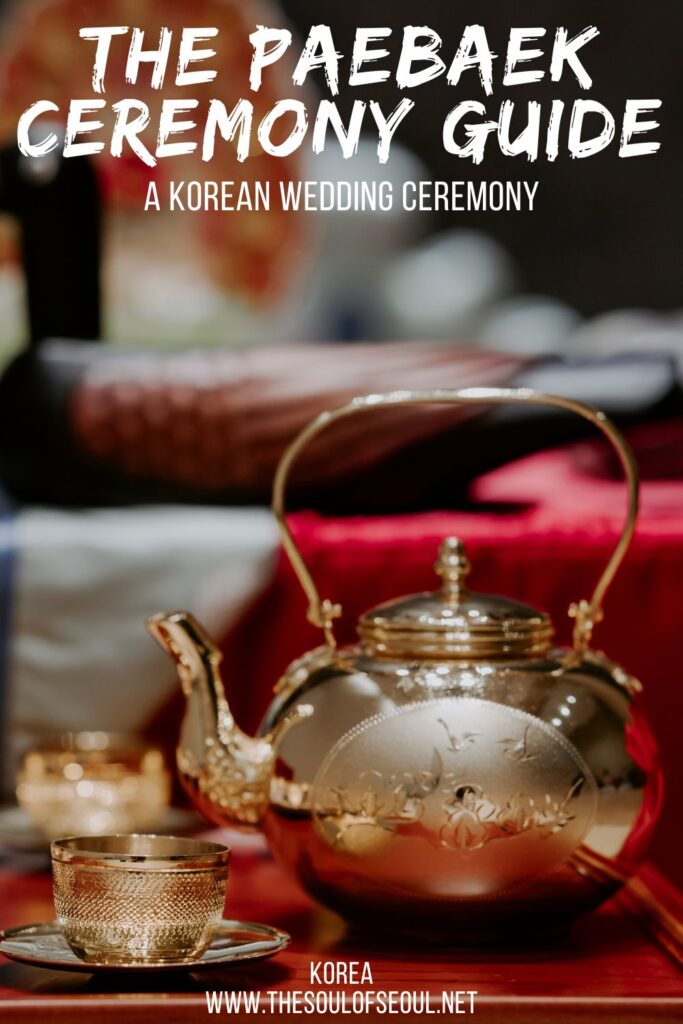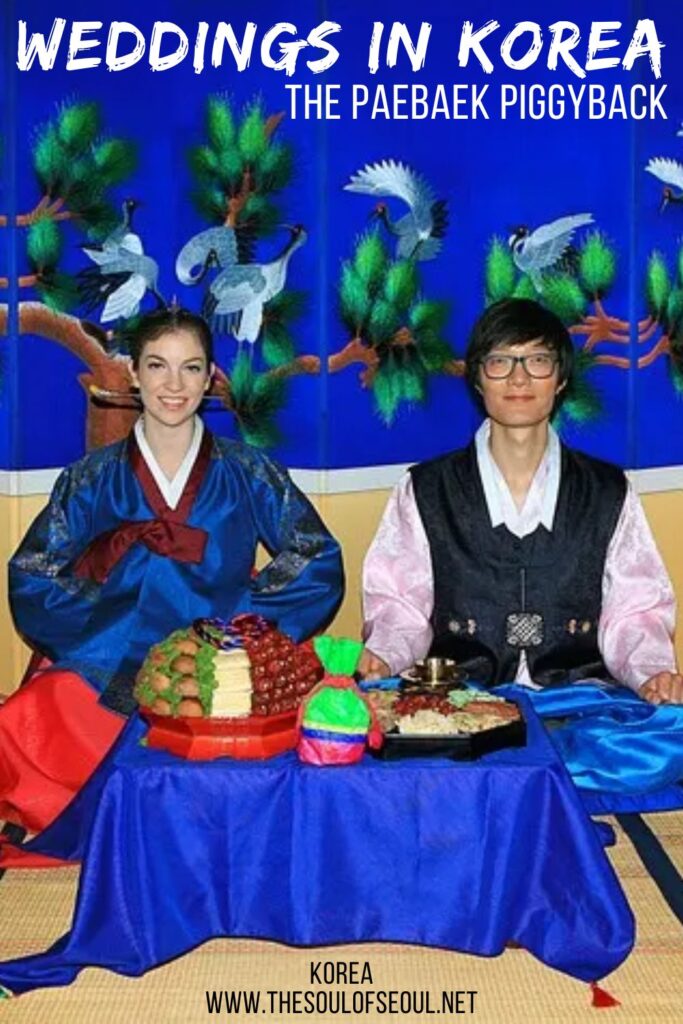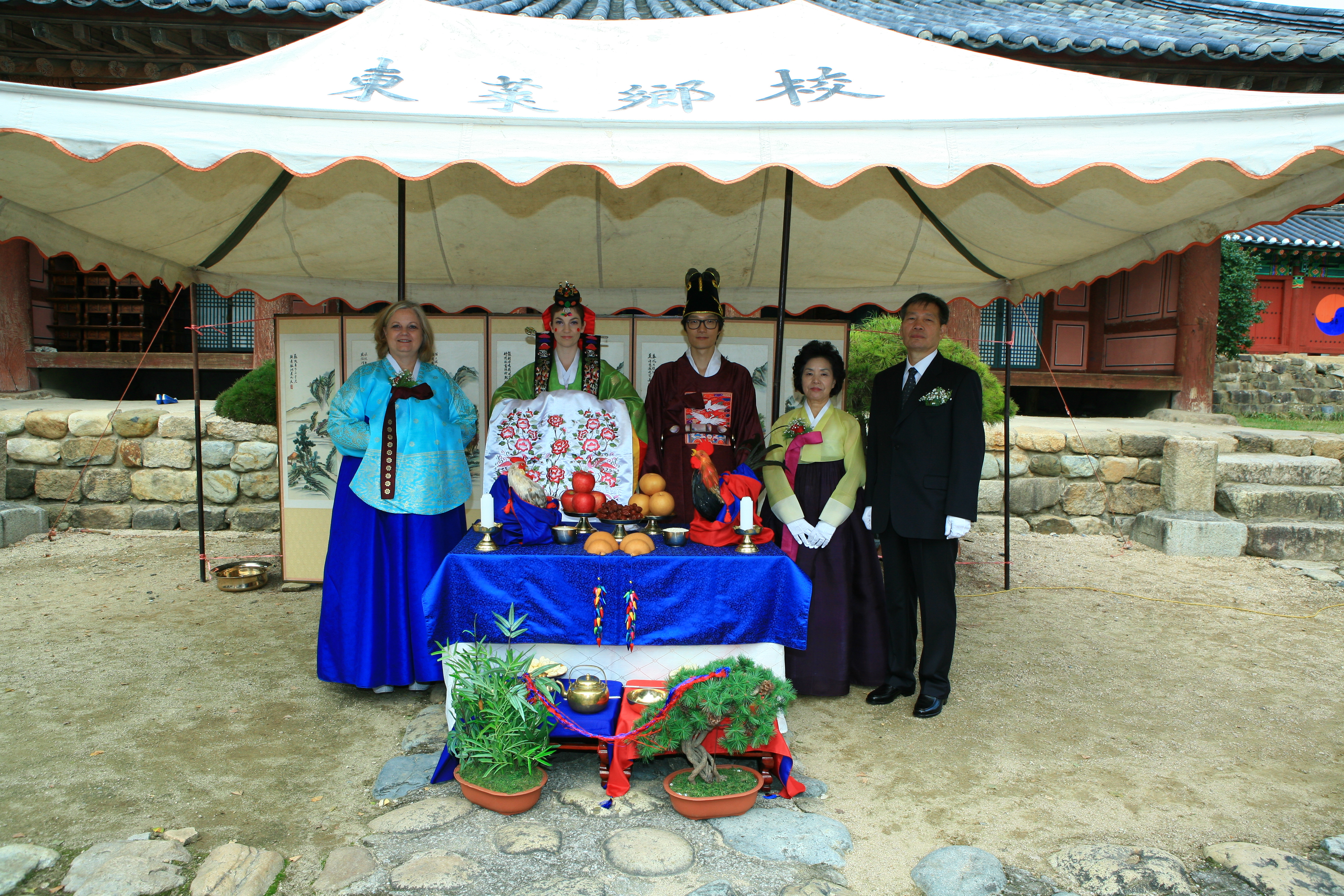A Korean Wedding Ceremony and The Paebaek Piggyback
Last Updated on December 19, 2024
Getting married in Korea? Wondering what a traditional wedding ceremony in Korea is like? Whether you’re having a modern wedding ceremony in Korea or a traditional wedding ceremony, one part of the events will be a paebaek ceremony. A unique and traditional step in the wedding process in Korea, this ceremony in which the bride and groom wear traditional Hanboks is what truly unifies the family. Here’s everything you should know about the paebaek ceremony and what it means.

Learn about the traditional paebaek ceremony in a Korean wedding ceremony:
- What is the paebaek ceremony?
- The history of the paebaek ceremony
- How to prepare for a paebaek ceremony
- The steps in a paebaek ceremony
- Common questions about a paebaek ceremony
(This post contains affiliate links, which means I receive a certain percentage of a sale if you purchase after clicking at no cost to you. These funds go to maintain the site. Thank you for your support.)
What is the paebaek ceremony?
Spelled paebaek, or pyebaek in English, this ceremony is the most important part of a Korean wedding ceremony and is a more intimate experience that symbolizes the unification of the two families. Traditionally, it symbolized the wife becoming part of the husband’s household and leaving her own, but today, it’s more of a ceremony to celebrate the unification of both families together.
The history of the paebaek ceremony
The paebaek ceremony is just one part of the larger formal traditional Korean wedding ceremony which is for all of the guests. After the more public ceremony, the close family gathers for this more intimate wedding ceremony only for the two families of the bride and groom. An intimate affair to combine the families as one united.



Traditionally in Korea, the bride would get married, leave her home and her family and live with her husband and in-laws. The ceremony was the beginning of that transition and would involve just the close family members. This was originally a ceremony for the groom’s family to formally accept the bride into their home. The paebaek ceremony was just one part of a larger post-wedding ritual called the hurye which involved the bride being paraded toward the groom’s home in palanquin carried by porters. The whole hurye ceremony took place over three days traditionally.
Today, the paebaek ceremony is much shorter and usually takes place just after the main ceremony. During this time, the guests are usually headed to the reception area and in my experience, just the immediate family members of the couple stay for the paebaek which usually takes place in another room or separate part of the building.
How to prepare for a paebaek ceremony
The space for a paebaek ceremony usually involves a bamboo mat on the floor with a low table at the center and a decorative folding screen is at the back. The folding screen should have some natural scenery on it if you can’t find a Korean one. Korean rosewood tables are used for many traditional ceremonies include the Jesa ceremony done on traditional Korean holidays.
The table is set with dried fruits and nuts and wine. The table usually has nine offerings covering it: dates to the east for the couple to rise early and work hard, chestnuts to the west to ward off evil spirits, dried meats and sweets so that the new mother-in-law accepts the new daughter-in-law with kindness and generosity, gingko nuts to bring eternal faith to their son, among others. These traditional table platters can be found at traditional markets in Korea like Gwangjang Market.
Next to the larger table, there is a smaller rosewood table with a Korean teapot and cups that will be used to serve each other.
The steps in a paebaek ceremony
Change into appropriate clothing
Following the wedding ceremony I was taken into a small room where the wonsam, or long overcoat, was removed along with the jokduri and bunyeo from my hair. You can learn more about a Korean wedding Hanbok here. I changed into a small blue top and a new hairpiece was placed on my head. Jae-oo and I made our way to the center room to join our families who had already been seated with my family on the left side and his family on the right.
Exchanging bows
To begin, my husbands parents moved to sit behind the table in front of the folded screen. We positioned ourselves in front of the table and bowed to my husband’s parents. We bowed deeply to the floor twice and then poured them each a cup of wine.
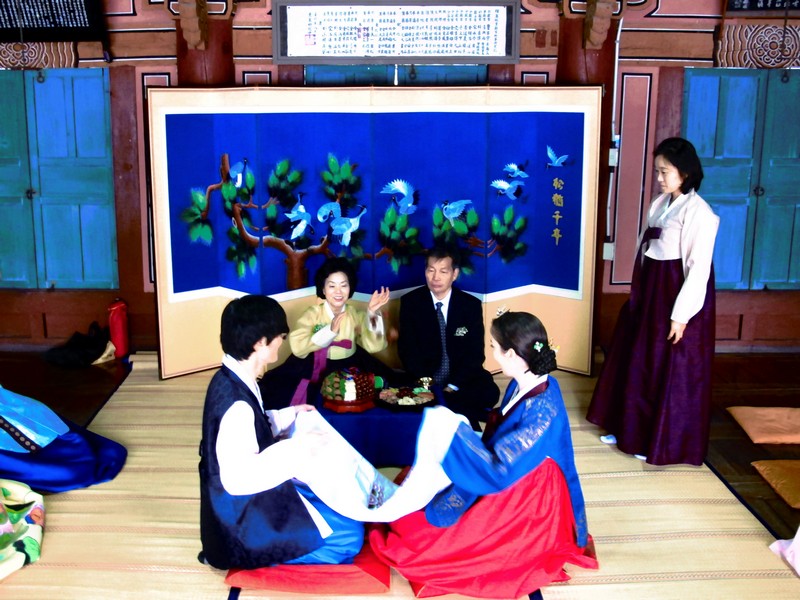
Give advice and blessings
My new in-laws then offered up words of wisdom. His mother said be happy and don’t fight, which set the trend for those following who basically said the same thing.
The tossing of the dates and chestnuts
One of the more exciting parts of the ceremony is the tossing of the dates and chestnuts. Taking my apron across we set up while Jae-oo’s mother took the chestnuts and prepared.
According to legend the number that you catch signifies how many girls (dates) and boys (chestnuts) you will bear. We caught them all and she threw quite a lot to us so I don’t think that legend will hold strong with us.
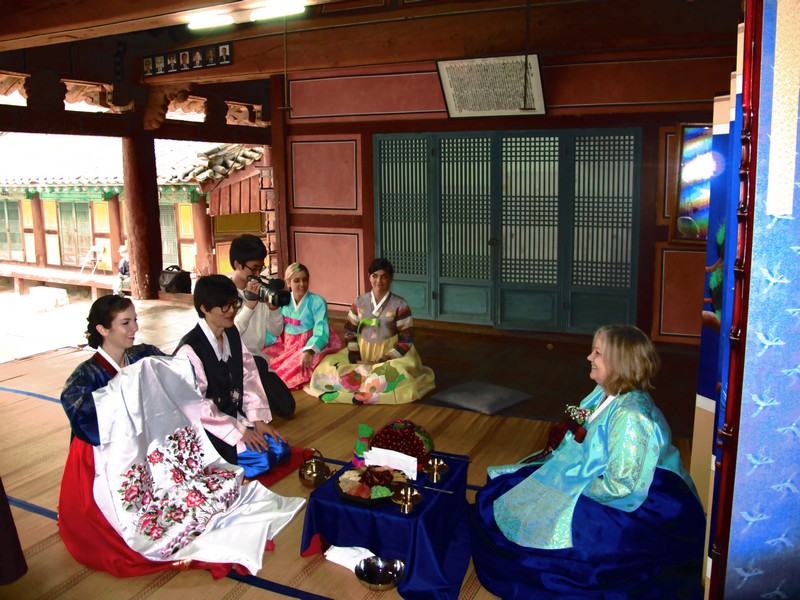
Repeat the steps with the bride’s family and extended family
As mentioned, traditionally, this ceremony was just for the groom’s family to welcome the new daughter-in-law, but now it’s for both families. So, next my mother was seated behind the table, followed by Jae-oo’s extended family and then my sisters. My sisters are younger than me so we didn’t have to bow all the way to the floor to them, just half way. They also weren’t given the wine to drink.

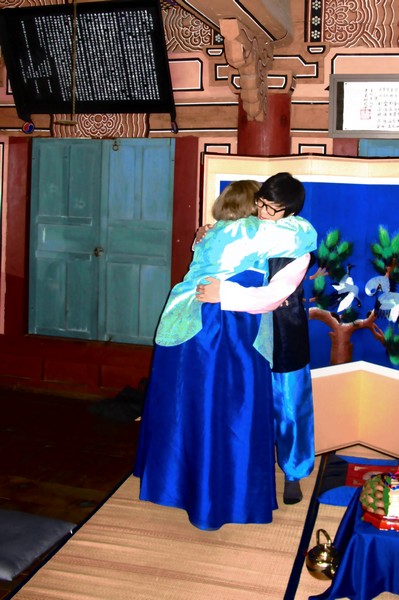
A family bow
All of the family members then rose and we all bowed to each other after some formal introductions. We each hugged our new mother-in-law and that was that. Our family was now one.
A piggyback ride
Then it was just me and Jae-oo seated behind the table. We poured each other a cup of wine, crossed arms and drank. He put a chestnut in my mouth and then had to come and get it. And then finally he lifted me on his back and was told he should take me around the table twice to show his strength. It was a great end to our ceremony. Who doesn’t like a piggyback ride?
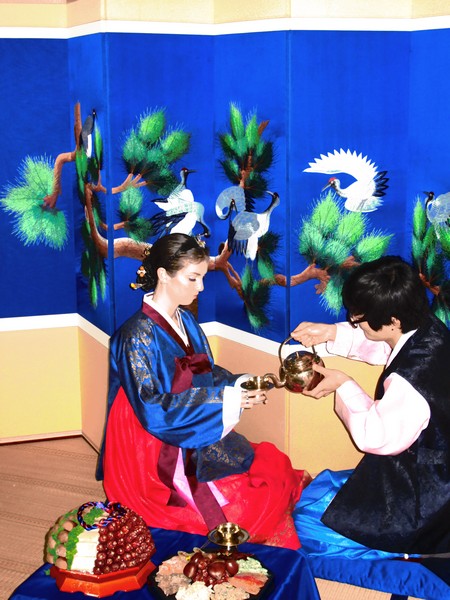
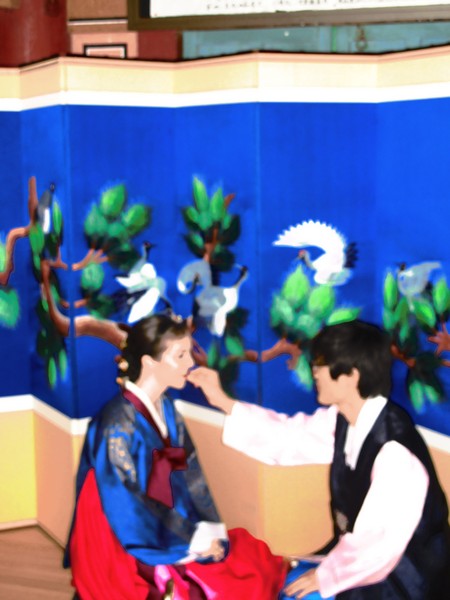
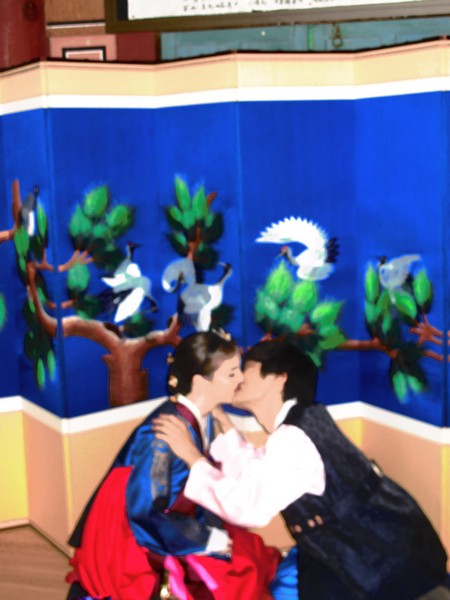
Common questions about a paebaek ceremony
Can non-family members attend the paebaek ceremony?
Some couples like the paebaek to be more public and open to everyone in attendance. If the space allows it and it’s clear you’re welcome to attend, go for it. In our case, we were in a traditional Hanok building with one side open to our guests though it was some what hidden by a traditional folding wall. Only our immediate family members were on the floor of the Hanok with us, but it was still open if guests wanted to see.
Some people chose to watch and we were fine with that. At some weddings I’ve attended, the paebaek is in a totally separate room with doors closed and just for the family. It’s usually pretty clear if you can watch or not.
Are Hanboks required at the paebaek ceremony?
In my experience in Korea, even at more modernized wedding ceremonies, the couple will change into a traditional Hanbok for the paebaek ceremony. It’s absolutely not a requirement for everyone to be in Hanboksk though. The ceremony is about unifying families and not about anyone’s style choices.
Did you like this post? Pin IT!
